
Chapter 15 Cluster
With the development of network technology, the network scale is getting larger and more network
devices are required, which may result in a more complicated network management system. As a
large number of devices need to be assigned different network addresses and every management
device needs to be respectively configured to meet the application requirements, manpower are
needed.
The Cluster Management function can solve the above problem. It is mainly used to central
manage the scattered devices in the network. A network administrator can manage and maintain
the switches in the cluster via a management switch. The management switch is the commander
of the cluster and the others are member switches.
The typical topology is as follows.
Figure 15-1 Cluster topology
Cluster Role
According to their functions and status in a cluster, switches in the cluster play different roles. You
can specify the role a switch plays. There are four roles.
Commander Switch: Indicates the device that can configure and manage all the devices in a
cluster. It discovers and determins the candidate switches by collecting NDP (Neighbor Discovery
Protocol) and NTDP (Neighbor Topology Discovery Protocol).
Member Switch: Indicates the device that is managed in a cluster.
Candidate Switch: Indicates the device that does not belong to any cluster though it can be
added to a cluster.
Individual Switch: Indicates the device with cluster feature disabled.
The roles can be changed from one to anther following the specified rules.
The current switch you create cluster is specified as the commander switch.
247


















